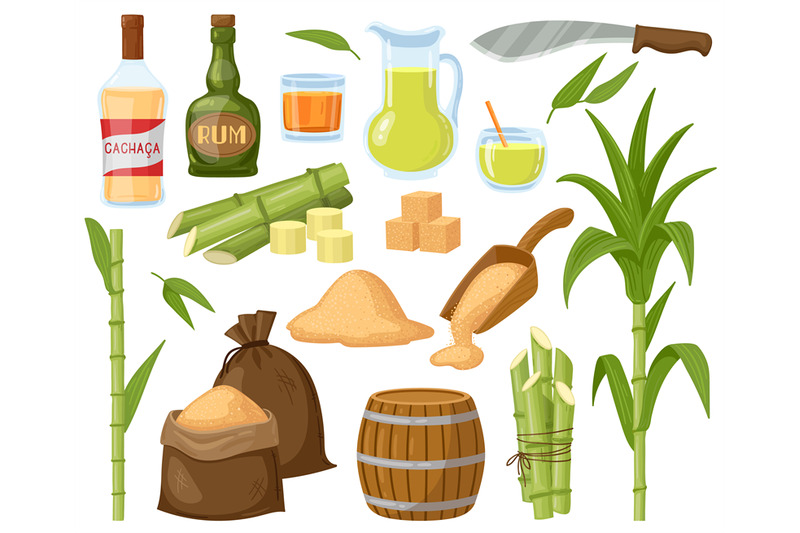Green sugar cane products That Promote Environmentally Friendly Living
Wiki Article
A Deep Study Sugar Cane: Insights on Production, Supplies, and Item Advancement
Sugar cane plays an important role in agriculture, underpinning economic situations in tropical areas. Its cultivation includes elaborate procedures affected by various ecological aspects. However, cultivators face considerable difficulties, consisting of climate adjustment and market changes. Technologies in item development are emerging in reaction to evolving customer demands. Understanding these dynamics is vital for realizing the future of this important crop and its influence on international markets. What exists in advance for sugar cane and its myriad applications?The Importance of Sugar Cane in Global Agriculture
Sugar cane serves as an important crop in worldwide agriculture, underpinning economic climates and food systems in lots of exotic areas. This versatile plant is primarily grown for its high sucrose content, which is fine-tuned into sugar, a staple component in countless food. Beyond sweetening, sugar cane is additionally vital for creating biofuels, particularly ethanol, adding to energy sustainability.The economic value of sugar cane reaches work, offering source of incomes for numerous farmers and workers in processing centers. In a number of nations, sugar cane growing and handling stand for significant sections of agricultural GDP, influencing profession balances and local development.Additionally, sugar cane's adaptability to numerous climates enhances its significance as a crop, making certain regular supply in global markets. Its byproducts, including molasses and bagasse, better diversify its utility, making it an important element in food, power, and market. Generally, sugar cane remains a foundation of farming efficiency worldwide.Cultivation Procedures: From Planting to Harvest
Growing sugar cane includes a collection of well-defined processes that guarantee ideal growth and yield. The growing starts with land prep work, where the dirt is tilled to safeguard optimum oygenation and drainage. Following this, seed cane, which includes fully grown stalks, is picked and reduced right into sections (sugar cane products). These sections are after that grown in furrows, making sure proper spacing to enable sunlight and nutrient access.Once planted, watering systems are utilized to keep sufficient wetness levels, as sugar cane flourishes in damp problems. Weeding and parasite administration are crucial during the expanding period to decrease competitors for sources. Nutrient application, consisting of plant foods, sustains durable development. As the plants develop, keeping an eye on for conditions and bugs continues.Harvesting usually takes place 10 to 24 months post-planting, depending on the variety. The canes are reduced close to the ground, making certain minimal waste, and are rapidly carried for processing to preserve sugar qualityGeographical Distribution of Sugar Cane Production
The geographic distribution of sugar cane production is largely formed by certain environment and dirt needs. Major creating nations, such as Brazil, India, and China, take advantage of exotic and subtropical environments that sustain the crop's development. Recognizing these elements provides understanding into the global landscape of sugar cane farming.Major Making Countries
Although sugar cane is expanded in various regions worldwide, certain nations dominate production due to desirable environments and farming methods. Brazil leads the worldwide market, accounting for roughly one-third of complete production, thanks to its extensive ranches and progressed cultivation techniques. India adheres to as a considerable producer, taking advantage of both beneficial climate condition and a huge residential market. China and Thailand likewise rank among the top producers, with reputable infrastructures sustaining their sugar sectors. Other noteworthy factors include the USA, Mexico, and Australia, each leveraging their special agricultural systems to improve result. These countries play a crucial role in the sugar cane supply chain, influencing global rates and accessibilityClimate and Dirt Demands
Ideal climate and dirt problems are critical for effective sugar cane production. Sugar cane flourishes in tropical and subtropical regions, needing cozy temperature levels between 20 ° C and 30 ° C (68 ° F to 86 ° F) These plants need abundant sunlight and rainfall, ideally between 1,500 to 2,500 millimeters annually, to guarantee peak development. The soil needs to be well-drained, productive, and abundant in raw material, with a pH level preferably between 5.5 and 8.5. Sandy loam or clay loam soils are specifically favorable to sugar cane cultivation, offering essential nutrients and water drainage. Geographic circulation is greatly affected by these factors, with significant production locations situated in Brazil, India, and China, where environmental conditions straighten with the plant's needs for growth and yield.
Challenges Encountered by Sugar Cane Growers
Sugar cane cultivators experience considerable difficulties that influence their resources. Climate modification introduces uncertain climate patterns, affecting crop yield and quality. Additionally, market value volatility produces monetary unpredictability, complicating long-lasting preparation for these agricultural manufacturers.Climate Adjustment Impacts

Exactly how do climate change impacts affect the practicality of sugar cane cultivation? Climbing temperature levels and unpredictable climate patterns notably test sugar cane cultivators. Enhanced heat can result in lowered returns, as the plants battle to thrive in extreme conditions. Furthermore, altered rains patterns result in either droughts or extreme flooding, both destructive to plant health. Parasites and illness are most likely to proliferate in warmer environments, further threatening production. Additionally, soil deterioration and salinization because of increasing water level can decrease cultivable land. These climatic modifications force farmers to adjust their techniques, commonly calling for financial investment in brand-new modern technologies and resistant plant varieties. Ultimately, the sustainability of sugar cane cultivation hinges on dealing with these i loved this climate challenges properly.

Market Value Volatility
Market value volatility provides considerable obstacles for sugar cane farmers, impacting their economic security and preparation. Variations in market value, driven by elements such as worldwide supply and demand, climate condition, and federal government policies, develop uncertainty for producers. This unpredictability makes it tough for growers to anticipate incomes and take care of operating budget efficiently. In addition, when costs go down unexpectedly, lots of farmers may have a hard time to cover production costs, bring about prospective financial distress. To alleviate these threats, some farmers turn to contracts or hedging approaches, yet these solutions might not come to all. Market rate volatility stays a relentless concern, affecting the general sustainability and profitability of sugar cane farming.Recognizing the Sugar Cane Supply Chain

Market Trends Affecting Sugar Cane Rates
The dynamics of sugar cane costs are affected by a variety of market patterns that mirror broader economic problems and customer habits. Worldwide demand for sugar and sugar-related products plays a vital function, with boosting rate of interest in organic and sustainably sourced products driving rates higher. In addition, variations in oil costs influence the price of production and transportation, further influencing market rates. Weather patterns are an additional substantial aspect; unfavorable conditions can bring about lowered yields and enhanced prices. Profession plans, tariffs, and global contracts likewise shape the market landscape, affecting supply chains and accessibility. Currency exchange rates can complicate international profession, impacting prices for both exporters and importers. Finally, changes in customer choices towards healthier choices might modify demand patterns, creating a ripple result on sugar cane pricing. Recognizing these interconnected trends is vital for stakeholders in the sugar sector.Innovations in Sugar Cane Product Advancement
Numerous developments in sugar cane item growth are improving the market and expanding its applications. Researchers are exploring alternative usages past conventional sugar, including biofuels, eco-friendly plastics, and health supplements. Breakthroughs in chemical processing strategies have actually improved the removal of important substances such as anti-oxidants and vitamins from sugar cane, advertising its usage in functional foods.Additionally, the development of genetically customized sugar cane varieties intends to boost return and resistance to parasites, while additionally enhancing the nutritional account of the plant. Developments in fermentation procedures have actually caused the production of top notch liquors stemmed from sugar cane, attracting an expanding market for craft spirits.Moreover, sustainable practices in cultivation and processing are obtaining grip, with a focus on reducing environmental effects. These innovations not just develop brand-new market chances but additionally cultivate a more lasting approach to sugar cane production, aligning with global fads towards environmentally friendly items.Frequently Asked Questions
What Are the Environmental Effects of Sugar Cane Farming?
The ecological influences of sugar cane farming consist of deforestation, loss anonymous of biodiversity, water air pollution from plant foods and pesticides, dirt deterioration, and greenhouse gas exhausts, every one of which greatly add to eco-friendly inequalities and environment change.
How Does Sugar Cane Growing Affect Resident Economies?
Sugar cane cultivation greatly influences local economic situations by developing work, stimulating farming markets, and creating revenue for farmers. It can additionally lead to financial dependency and changes based on market needs and ecological problems.What Are the Key Vermin and Diseases Affecting Sugar Cane?
The primary bugs affecting sugar cane consist of the sugarcane borer and aphids. Conditions such as red rot and smut substantially impact return. Farmers have to apply integrated pest monitoring methods to alleviate these threats successfully.Just How Is Sugar Cane Processed Into Different Products?
Sugar cane handling involves crushing the stalks to draw out juice, adhered to by clarification, evaporation, and formation. This process yields raw sugar, molasses, and ethanol, each offering distinct objectives in various markets, from food to power.What Are the Nutritional Aspects of Sugar Cane?
The nutritional elements of sugar cane consist of essential minerals and vitamins, especially B vitamins, calcium, and iron. It hop over to these guys also has fiber, though primarily made up of sucrose, which offers power but lacks considerable nutrients.Report this wiki page